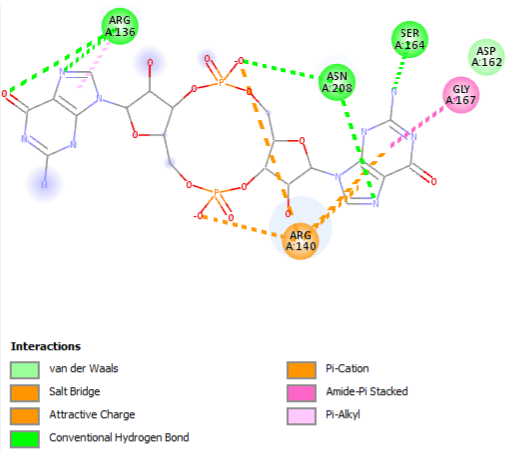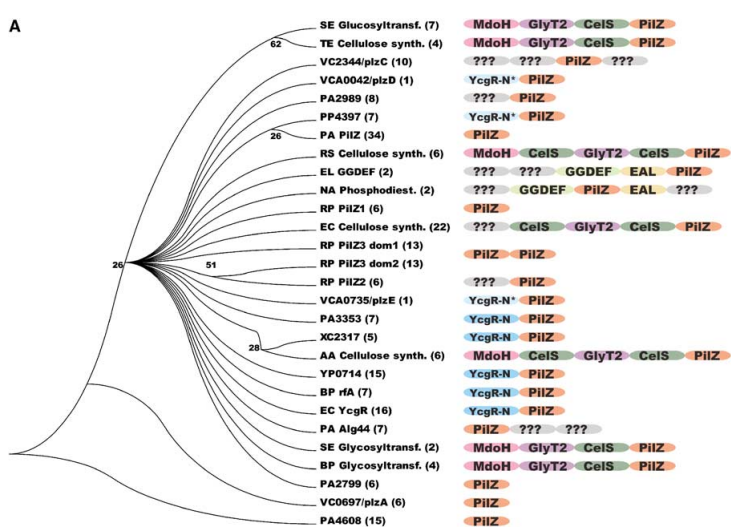User:Eduardo Soares/Sandbox 1
From Proteopedia
(Difference between revisions)
| Line 33: | Line 33: | ||
Cyclic diguanylate monophosphate (c-di-GMP) signaling plays a crucial role in the life cycle of Vibrio cholerae, a bacterium responsible for causing the human disease cholera. Cholera is characterized by potentially life-threatening diarrhea resulting from the secretion of cholera toxin. Studies have revealed that c-di-GMP regulates the expression of virulence genes in V. cholerae. Among the proteins involved in c-di-GMP signaling is VieA, a c-di-GMP phosphodiesterase that modulates cholera toxin production by influencing the cytosolic levels of c-di-GMP. Additionally, the genome of V. cholerae contains five PilZ domain-containing proteins, one of which is VCA0042. These proteins diverged in sequence before the divergence of the Vibrio lineage (Figure 1A) and are believed to function as regulators of various cellular processes controlled by c-di-GMP. VCA0042 has recently been named PlzD and has been shown to bind c-di-GMP when immobilized on nitrocellulose in its native conformation. Furthermore, a study has demonstrated that either VCA0042/PlzD or VC2344/PlzC, another PilZ domain-containing protein in V. cholerae, is required for efficient colonization of the intestines of mice by the El Tor biotype of V. cholerae in a virulence assay. | Cyclic diguanylate monophosphate (c-di-GMP) signaling plays a crucial role in the life cycle of Vibrio cholerae, a bacterium responsible for causing the human disease cholera. Cholera is characterized by potentially life-threatening diarrhea resulting from the secretion of cholera toxin. Studies have revealed that c-di-GMP regulates the expression of virulence genes in V. cholerae. Among the proteins involved in c-di-GMP signaling is VieA, a c-di-GMP phosphodiesterase that modulates cholera toxin production by influencing the cytosolic levels of c-di-GMP. Additionally, the genome of V. cholerae contains five PilZ domain-containing proteins, one of which is VCA0042. These proteins diverged in sequence before the divergence of the Vibrio lineage (Figure 1A) and are believed to function as regulators of various cellular processes controlled by c-di-GMP. VCA0042 has recently been named PlzD and has been shown to bind c-di-GMP when immobilized on nitrocellulose in its native conformation. Furthermore, a study has demonstrated that either VCA0042/PlzD or VC2344/PlzC, another PilZ domain-containing protein in V. cholerae, is required for efficient colonization of the intestines of mice by the El Tor biotype of V. cholerae in a virulence assay. | ||
[[Image: Figura 1A.png]] <ref>Benach J, Swaminathan SS, Tamayo R, Handelman SK, Folta-Stogniew E, Ramos JE, Forouhar F, Neely H, Seetharaman J, Camilli A, Hunt JF. The structural basis of cyclic diguanylate signal transduction by PilZ domains. EMBO J. 2007 Dec 12;26(24):5153-66. doi: 10.1038/sj.emboj.7601918. Epub 2007 Nov 22. PMID: 18034161; PMCID: PMC2140105.</ref> | [[Image: Figura 1A.png]] <ref>Benach J, Swaminathan SS, Tamayo R, Handelman SK, Folta-Stogniew E, Ramos JE, Forouhar F, Neely H, Seetharaman J, Camilli A, Hunt JF. The structural basis of cyclic diguanylate signal transduction by PilZ domains. EMBO J. 2007 Dec 12;26(24):5153-66. doi: 10.1038/sj.emboj.7601918. Epub 2007 Nov 22. PMID: 18034161; PMCID: PMC2140105.</ref> | ||
| + | |||
| + | <ref> Purificação, Aline Dias da, et al. The World of Cyclic Dinucleotides in Bacterial Behavior. Molecules, vol. 25, n. 10, Janeiro de 2020, p. 2462. www.mdpi.com, https://doi.org/10.3390/molecules25102462. </ref> | ||
| + | <ref> Pecina, Anna, et al. The Stand-Alone PilZ-Domain Protein MotL Specifically Regulates the Activity of the Secondary Lateral Flagellar System in Shewanella putrefaciens. Frontiers in Microbiology, vol. 12, 2021. Frontiers, https://www.frontiersin.org/articles/10.3389/fmicb.2021.668892. </ref> | ||
== Relevance == | == Relevance == | ||
Revision as of 21:36, 25 June 2023
VCA0042/plzD complexed with c-di-GMP
Introduction
The PDB code 2RDE represents a PilZ protein complexed with cyclic diguanylate monophosphate (c-di-GMP) in Vibrio cholera there is a molecular interaction involved in the regulation of bacterial biofilm formation and motility. The complex is formed by the binding of the small signaling molecule c-di-GMP to a protein domain known as PilZ. This interaction plays a crucial role in bacterial physiology and is implicated in various cellular processes.
| |||||||||||
References
- ↑ Benach J, Swaminathan SS, Tamayo R, Handelman SK, Folta-Stogniew E, Ramos JE, Forouhar F, Neely H, Seetharaman J, Camilli A, Hunt JF. The structural basis of cyclic diguanylate signal transduction by PilZ domains. EMBO J. 2007 Dec 12;26(24):5153-66. doi: 10.1038/sj.emboj.7601918. Epub 2007 Nov 22. PMID: 18034161; PMCID: PMC2140105.
- ↑ Purificação, Aline Dias da, et al. The World of Cyclic Dinucleotides in Bacterial Behavior. Molecules, vol. 25, n. 10, Janeiro de 2020, p. 2462. www.mdpi.com, https://doi.org/10.3390/molecules25102462.
- ↑ Pecina, Anna, et al. The Stand-Alone PilZ-Domain Protein MotL Specifically Regulates the Activity of the Secondary Lateral Flagellar System in Shewanella putrefaciens. Frontiers in Microbiology, vol. 12, 2021. Frontiers, https://www.frontiersin.org/articles/10.3389/fmicb.2021.668892.


